
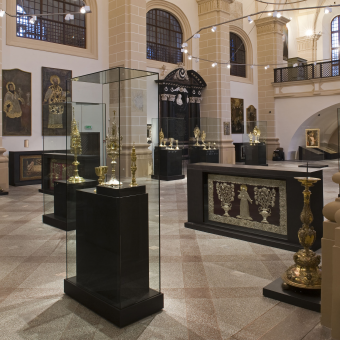

The Vilnius Cathedral Treasury is the oldest and most extensive of all the treasuries preserved in Lithuanian churches. The first items it acquired were rich liturgical articles donated by Jogaila and Vytautas of the Gediminid dynasty and their wives, along with gifts from abroad sent to celebrate Lithuania’s official adoption of Christianity. Heads of state, nobility and bishops bestowed magnificent liturgical articles on the Cathedral: these were crosses, chalices, reliquaries, monstrances. In wartime the valuables were removed or hidden, the last time it happened when World War II began. On the eve of World War II, the contents of the Vilnius Cathedral treasury were hidden in a wall and bricked over. The treasure was discovered in 1985, but was not shown to the public until 1999-2003 exhibitions at the Lithuanian Art Museum. In 2006, the entire Cathedral treasury was returned to Vilnius Archdiocese, and since 2009 it has been on display at the Church Heritage Museum.
Discovery of Vilnius Cathedral treasury. Photo by R. Budrys, 1985, Lithuanian National Museum of Art
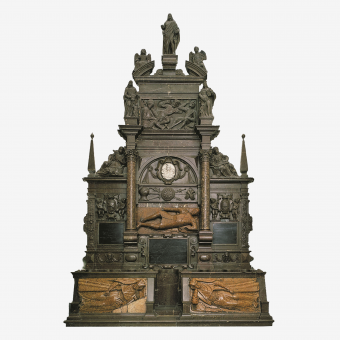
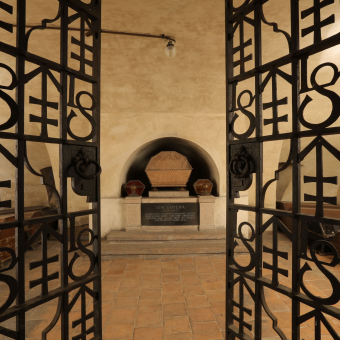
The Church of St. Michael the Archangel is the first sanctuary in Lithuania built as a mausoleum for a noble family. There are five burial crypts beneath the floor of the church. In some of them nuns were buried, in others were laymen. Leonas Sapiega, his sons Jonas Stanislovas and Kristupas and other family members were buried in the family crypt. The Czarist Russian army, which took Vilnius in 1655, ravaged, burned and plundered the city slaughtering thousands of people. The Cossacks murdered the nuns and the city residents who were hiding in the convent, they also looted the church and the vault with the Sapiega graves. Taking the expensive coffins and burial clothes, they threw the remains in the street.
Four early 17th-century burial monuments for the members of the Sapiega family have survived in the church and are of great value. They show the power, wealth and subtle artistic taste of those who commissioned them.
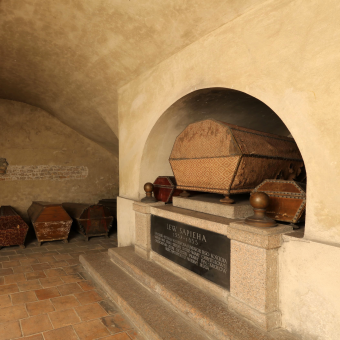
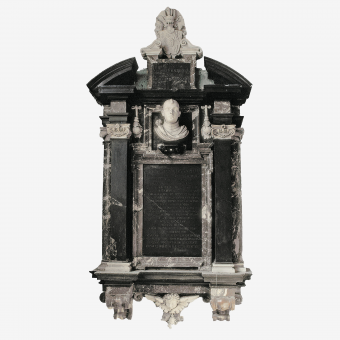
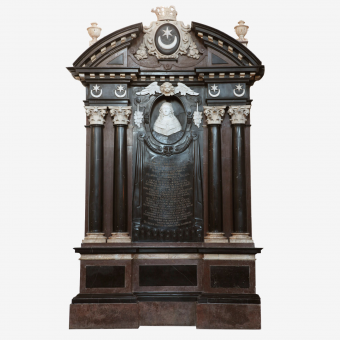
The monument to Kazimieras Leonas Sapiega’s wife Teodora Kristina (†1652) stands out for its lavishness and elegance. The woman, who was famous for her beauty, is depicted with the 17th century hairstyle and clothing. The star and crescent at the top symbolize the Tarnovskis family victories in battles with the Turks.

Jonas Stanislovas Sapiega’s (1588–1635) burial monument is incorporated into the portal of the door to the sacristy. This arrangement, which is extremely rare in Lithuania, symbolized the passage from the world of the living to that of the dead, from temporal life to eternal one.
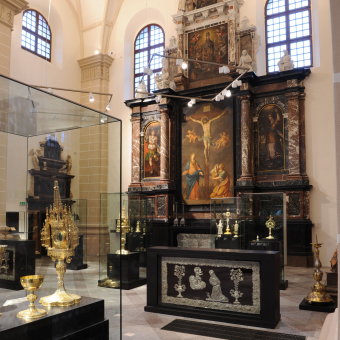
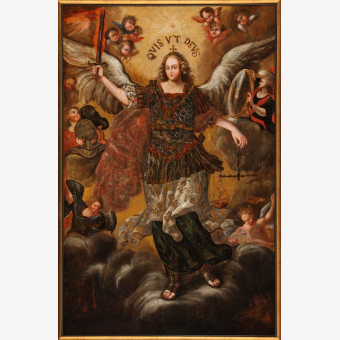
Vilnius, c. 1691
This painting was made for Bernardine Franciscan Sisters Church of St Michael the Archangel. The Archangel is portrayed as leader of the heavenly host who battles the forces of evil with a fiery sword. His left hand holds a scale to implement justice on the day of Final Judgement. The Latin inscription gives Hebrew meaning of the name Michael: “Who is like God”.
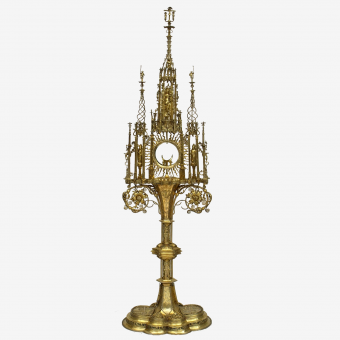

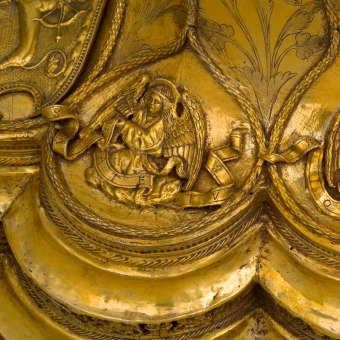
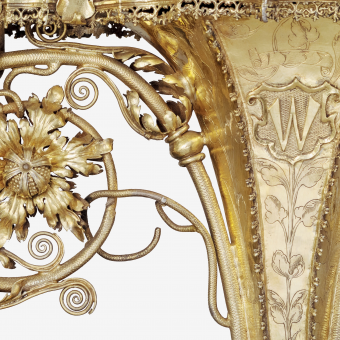
Vilnius, 1535
With a weight of about 20 kg and a height of 150 cm, this is one of the largest monstrances in all Central Europe. The vessel, which has Late Gothic and Renaissance traits, is thought to be the work of an unknown goldsmith in Vilnius. One of the most prominent noblemen of the time, Albertas Goštautas, Chancellor of the Grand Duchy of Lithuania and Voivode of Vilnius, originally gave this monstrance of remarkable size and artistic value as a gift to the Church of St Nicholas in the town of Geranainys. Numerous ornamental figures adorn the liturgical vessel. The photograph shows a small sculpture of St Adalbert (Voitecus), the patron saint of the founder. The other side depicts St Nicholas, the patron of the church in Geranainys. The Blessed Sacrament would be placed in the center of the monstrance. Above it there is an image of the Blessed Virgin Mary and Child, higher up there is Christ pointing to his wounds, and the very top is crowned with the scene of the Crucifixion. Under the glory the heraldic mark of the Goštautas family is incorporated, above which the year of the monstrance creation is engraved. The symbols of the four Evangelists are incorporated into the base of the monstrance.

Vilnius, 1582-1583
This uniquely shaped chalice is richly decorated with Renaissance artistic ornaments and figures of saints. Its unusually abrupt base bears images of the Savior and the twelve Apostles, while the cup has images of the four Evangelists. It is guessed that the chalice was donated to the jesuit Church of St. James in Riga by the Bishop of Vilnius and later Krakow, Cardinal and Count Jurgis Radvila on the occasion of the ordination of its priest in 1583. In 1612, while retreating from Riga, the Jesuits took the chalice to the Church of St. Ignatius in Vilnius, and after the liquidation of the Jesuit order, the vessel was transferred to the Carmelite Church of St. George; in the 19th century, the bishop assigned it to the Vilnius Cathderal.
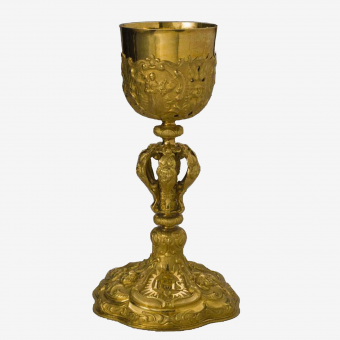
Andrzej Mackensen I, Gdansk, c. 1646
This pure gold chalice is the largest in Lithuania. It is masterfully crafted with artistic ornamentation and a rare composition of the base with an openwork knob. St Francis of Assisi, St Anthony of Padua, St Bonaventure, St Casimir and St Stanislaus are depicted on the chalice. The chalice also has a great memorial value – according to one of the versions, the golden chalice was donated to the Church of the Friars Minor of Druja by the endower of the church, the famous patron and supporter of the Catholic Church Kazimieras Leonas Sapiega. The Sapiega's coat-of-arms is represented on the foot of the vessel.
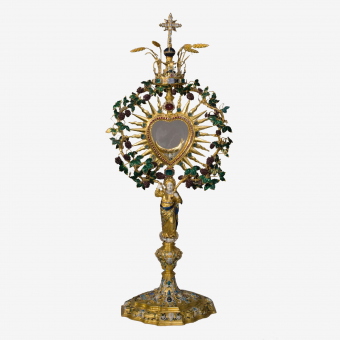
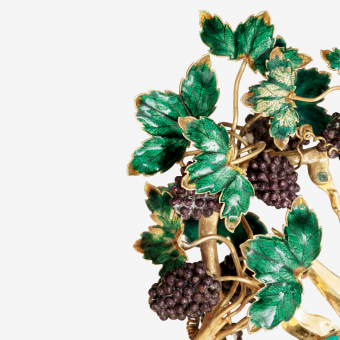
Vilnius (?), 1649-1655
One of the most valuable vessels in the cathedral treasury was a gift from Vilnius Bishop Jurgis Tiškevičius. The monstrance is remarkable for its highly colorful use of enamel, which is rare in Lithuania, as well as its combination of gold and precious stones in an impressive arrangement that tells of the mysteries of God’s love and redemptive sacrifice. A small figure of the Savior’s Mother, the Blessed Virgin Mary, has an important place in the overall composition.
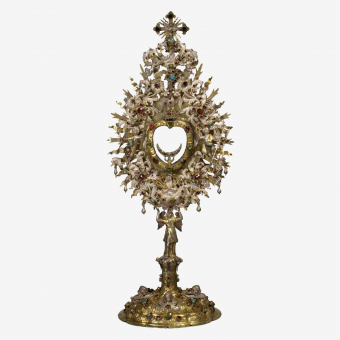
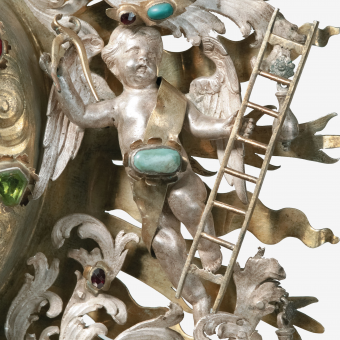
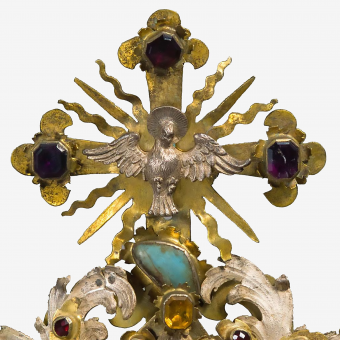
Wolfgang Caspar Kolb, Augsburg, 1691-1695
This heavily ornamented Baroque monstrance bears the marks of the city of Augsburg and the initials of one of the best-known guilds of the time. Samogitian Bishop Kazimieras Pacas may have donated the valuable art work to Vilnius Cathedral. The iconography of the monstrance tells of Christ Passion and self-sacrifice for love of mankind. Two small angels with the instruments of Christ Passion are depicted on the sides of the monstrance. The left angel holds the cross and a hammer, while the right one holds the ladder and pincers that were needed to remove Jesus body from the cross. Above the heart-shaped receptacle for holding the Blessed Sacrament, a pelican is depicted sitting in its nest. This bird was said to cut open its breast in times of famine and feed its young with its blood. The pelican thus became the symbol of Christ sacrifice for love of mankind.

Augsburg, 1691-1695
The chalice with intricate enamel painting depicts the scenes from Christ Passion: the Last Supper, the Agony in the Garden, the Betrayal, the Flagellation, the Ecce Homo, and Christ before Caiaphas. The vessel represents the highly advanced German school of goldsmithery, which was fond of lush forms and colourful décor.
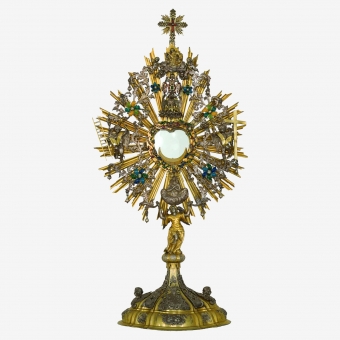
Johann Larry, Vilnius, 1751
This earliest rococo monstrance in Lithuania recalls another one which was made somewhat earlier in Augsburg and is kept in Vilnius Cathedral. The craftsman incorporated ornaments that believers donated as votive offerings to Trakai Mother of God.
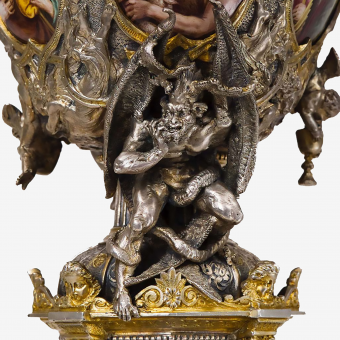
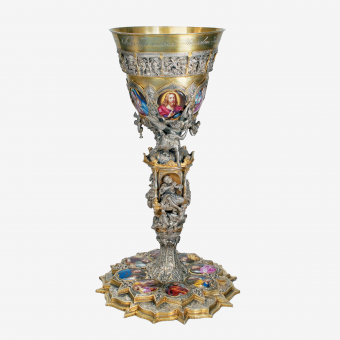
Western Europe, prior to 1854
This chalice is thought to have been created not for liturgical use but as a work of art to express an unconventional interpretation of traditional Byzantine iconography. Scenes from the life of Christ are cast on the chalice. It has enamel paintings of the Savior, the Blessed Virgin Mary, St Mary Magdalene and the Apostles. It also incorporates elements that are unusual in religious art: the allegories “Children’s Love for Parents” and “Grief with the Emblem of Death”, and the image of Satan crushed with the Blood of Christ. It was the famous collector Count Mykolas Tiškevičius of Biržai who donated the chalice to Vilnius Cathedral.
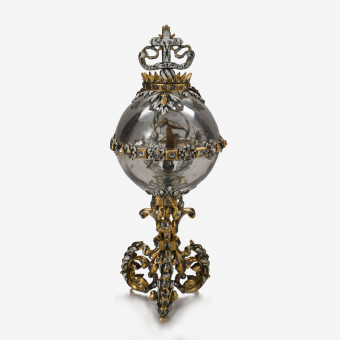
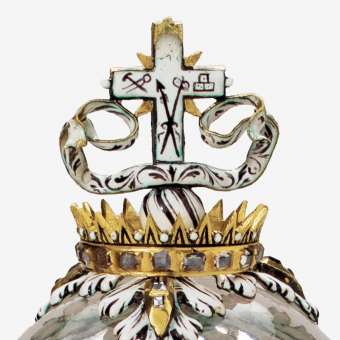
Florence, 17th c.
This masterpiece of jeweller’s art, embellished with enamel and diamonds, fascinates with its subtle forms and elegance. The reliquary belonged to Vilnius Bishop Mikalojus Steponas Pacas and after his death it was given to Vilnius Cathedral. The Pacas family of Lithuanian nobility traced their origins to the Pazzi noble family of Florence and spread devotion to the holy “kinswoman” in Lithuania.
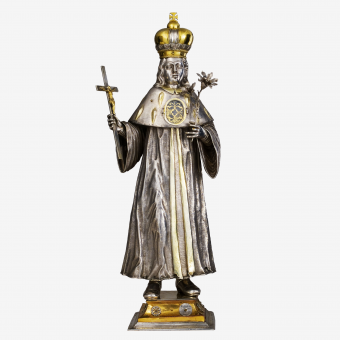
Vilnius, 1637
The noble Gosievskis family gave this statuette with relics of the saint to Jesuit Church of St Casimir in Vilnius. In the early 19th century, after the Jesuit order was suppressed and the church made into a parish, the reliquary was moved to the altar in Vilnius Cathedral. A matching figure of bishop St Stanislaus was added, as during Polish-Lithuanian Commonwealth these saints were typically shown together as the patrons of the two states.
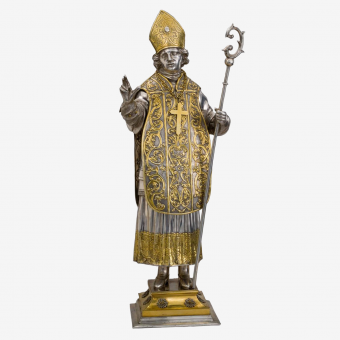
Vilnius, c. 1728-1735
Bishop Bogusław Korwin Gosiewski of Smolensk donated this small statue of St Stanislaus to Vilnius Cathedral. In 1815, the work together with some other valuable items was stolen. In the early 19th century it was regained and adapted to become a decoration of the main altar.
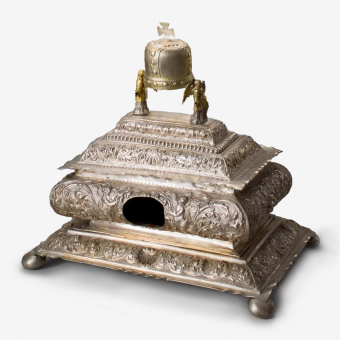
Vilnius, 1705-1712
In about 1705 Vilnius Cathedral acquired a relic belonging to Josephat Kuncevičius, who was the Greek Catholic archbishop of Polotsk. The reliquary in the form of a sarcophagus was commissioned specially for it. The vessel is decorated with acanthus leaves and crowned with the Greek Catholic archbishop’s miter. Until World War II, the reliquary was carried in annual processions on the feast of St Josephat.
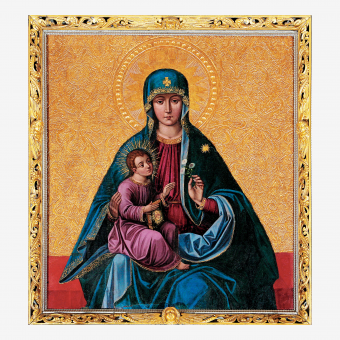
The church of Trakai was not damaged during World War II, but it was decided to hide the most important valuables from its treasury. The most valuable items were buried inside the church. Among them was the great monstrance and golden crowns of Mother of God painting. The hiding place was opened in 1975 during the renovation of the church. A part of Trakai chuch treasure is now preserved in the Church Heritage Museum.
The painting of the Blessed Virgin Mary is one of the earliest and most venerated images in Lithuania. The legend says it was a gift from Byzantine emperor to Vytautas, the Grand Duke of Lithuania. Accounts of special graces and miracles associated with the painting date back to the beginning of the 17th century.
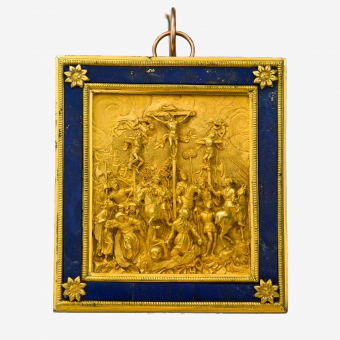
Augsburg (?), Munich (?), late 15th-early 16th c.
This plaque was donated to Vilnius Cathedral in 1817 by a famous Lithuanian educator and philanthropist Count Povilas Ksaveras Bžostovskis. Previously it may have been a part of a small altar for personal piety, which the count brought back from travels in Europe. The composition of the relief of the plaquette and the rendering of the figures is typical of early Renaissance of Central Europe, though the influence of Italian art of that period can also be noticed. It is set in a Classicist frame adapted for the image in the early 19th century.
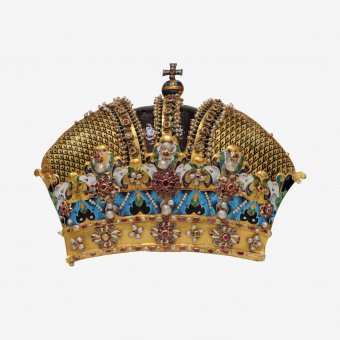
Covering for image of the Blessed Virgin Mary, Vilnius, 1677
Crown of the Blessed Virgin May, Augsburg (?), c. 1630-1655
Vilnius Bishop Mikalojus Steponas Pacas commissioned the silver-gilt framing for the painting. Demonstrating rare craftsmanship of jeweller’s art, it reflects the painted clothing and varied textures with great precision. Numerous holes in the framing were caused by people while attaching votive offerings, which were works of jewelry intended to show gratitude for the obtained graces. As early as in the 17th century, Trakai painting had several gilded crowns of varying sizes. Only one of them has survived and adorns the image in the church altarpiece. Other crowns belonging to the image are from later times. The photograph shows the largest gold crown embellished with enamel, pearls and gemstones.
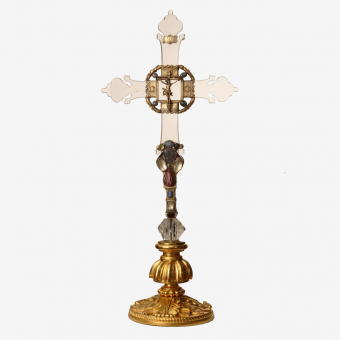
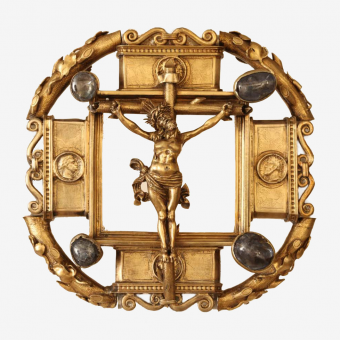
Cross – Vilnius (?), 1530-1539; crystal parts – Venice, c. 1300; base – Vilnius, after 1836
Count Albertas Goštautas of Geranainys left this cross with relics of St. Eustachius to Vilnius Cathedral in his will. The person who crafted the reliquary was an excellent Renaissance-era artist. The crystal cross and large gemstones below it are thought to be older; works of similar form, following Byzantine jeweller’s art specimens, were made in Venice in the second half of the 13th century. In the center of the reliquary there is a structure that joins the crystal bars and a gilded silver image of Crucified Christ. The metal crosspieces are decorated with a Renaissance vine motif and, following the fashion of the time, with the images of Roman emperors.
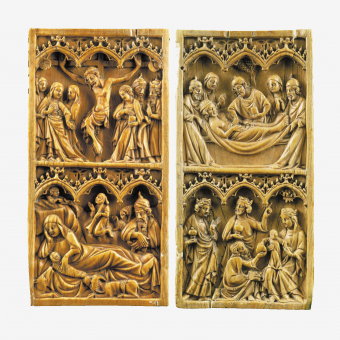
France (?), the 2nd half of 14th c.
It is the oldest Gothic plastic artwork in Lithuania. Four Gospel scenes are carved in ivory: the Birth of Christ, the Adoration of the Magi, the Crucifixion, and the Laying in the Tomb. Similar works were created in Byzantium in early Christian times, but from the 9th century France became a hub for this type of art.
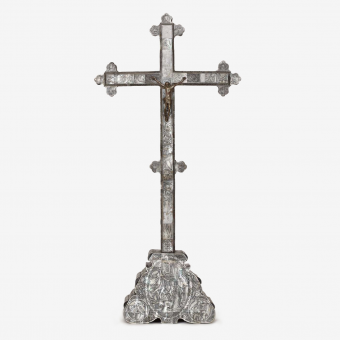
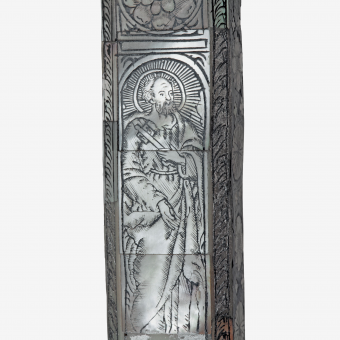
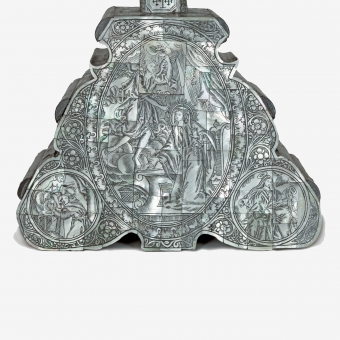
Palestine (?), 18th c.
Flower motifs, angel heads and figures of saints are carved on this Baroque cross. Below the cross, the scenes of the Annunciation to the Blessed Virgin Mary, St Anthony of Padua vision and Mary’s Visit to Elizabeth are depicted. The mark of Jerusalem cross suggests the work was created in Franciscan monastery workshops in the Holy Land and brought to Lithuania by an unknown pilgrim.
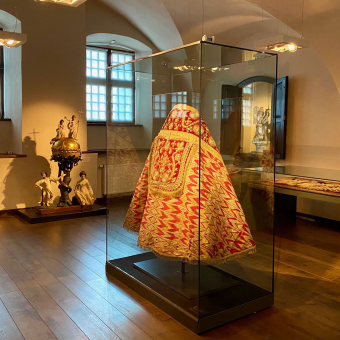
The sacristy is a place for clergy to vest and for storing the items needed for liturgical use. At present the church sacristy contains an exhibit of liturgical vestments.
At all times and in all religions, liturgical vestments sought to distinguish a clergyman among other believers, as if emphasizing the significance and nobility of religious ceremony. The forms of the vestments used in the liturgy of the Catholic church were mainly inherited from the classical tradition, and their purpose was finally established in the Middle Ages; in the newest times it changed very insignificantly and did not adapt itself to the rapidly changing secular fashions. Only some minor details of the vestment, the types or patterns of textiles did change. Vestments of clergymen were made of expensive textiles: silk, velvet, bombast, brocade, damask, also finest wool or canvas. Most often they adorned with lace, appliqué, embroidered in silk, gold and silver, and decorate with frills and galloons.
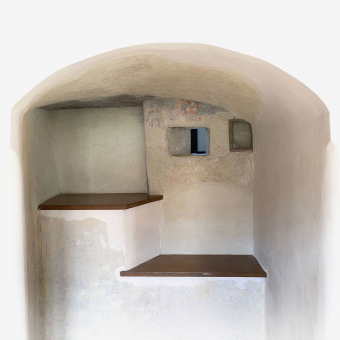
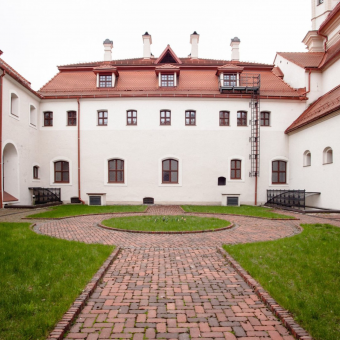
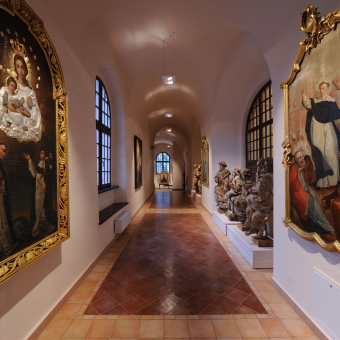
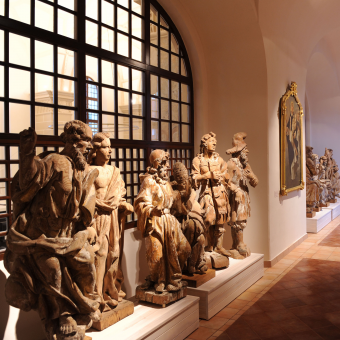

Vilnius, late 17th c. - 1701
These sculptures were originally made for the main altar of Saints Peter and Paul Church in Vilnius. They expressively depict the Apostles, the Evangelists and characters symbolizing various nations. It is thought that the arrangement was meant to tell of the descent of the Holy Spirit, described in the Acts of the Apostles, at the time when Christ disciples spoke to people gathered from the whole world in their native languages.